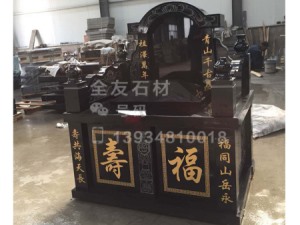Company Name: Hunyuan County Quanyou Stone Processing Factory
Contact: Mr. Wang
Tel: 13754914913
Company fixed line: 0352-8425006
Company fax: 0352-8425088
Company mailbox: 935913883@qq.com
Company address: Industrial Park, Hunyuan County, Datong City, Shanxi Province
What does the tombstone mean?
Let's talk about "gu" first. In Chinese, "gu" has two meanings: one is deceased and no longer exists. For example, "old friend", "homeland"; another meaning refers to the past. For example "Old person" or "story". Of course, the "gu" on the tombstone refers to the former: the deceased person. Many people may feel questioned after reading this: Is it possible that the name on the tombstone will still be a living person? Therefore, I think This "gu" has a taste of superfluous. But it is not the case. Chinese culture advocates prudent pursuit of the end, and this "gu" is a proxy: the memory of the plot is pinned in this "gu". At the beginning, the word "Xian" appeared on tombstones, often referring to the fact that the owner of the tomb had a certain success and a prominent position in life.
For example, if you are an official in the DPRK, or have any fame, you must at least say someone like a squire before you can use the word "Xian" on the tombstone. On the tombstones of ordinary people, the word "Xian" is used, which means "Xian". The meaning is similar to "計", and it is generally considered to play a role of emphasis. However, with the development of society, many ordinary people also use the word "Xian" on the tombstones of people who have passed away at home. In fact, I personally feel that the deceased It's over, there is no difference between the prominence in life and the time of death. Therefore, "Hsien" can be used on tombstones as a courtesy in the sense of praise, regardless of class or status.
Then it says "Kao". In ancient times, the book that determined Chinese etiquette was called the Book of Rites, which, as the name suggests, was a book that recorded all aspects of Zhou's rituals. It was regarded as one of the "Five Classics" by Confucians in later generations. The Book of Rites can be regarded as one of the compulsory subjects. The Book of Rites has such a stipulation in terms of appellation: when the father is alive, he is called his father, and after his death, it is called "Kao". .The so-called "妣" has the same origin as "Kao", referring to the mother when she was alive and called "妣" when she died. In the idiom, there is "ru mourning for the concubine", which refers to the same as if both parents died. .At present, the convention on many tombstones is: Therefore, the characters of XX and XX are displayed. According to Chinese tradition, the mode of joint burial is often practiced. Therefore, under one tombstone, two deceased people are often buried.
In ancient times, the cost of making a tombstone was very high: first, you needed to go to a mason to buy a tombstone, and then ask the mason to engrave on the tombstone. The size, specification, and material of the tombstone determine the price of the tombstone, and the number of words on the tombstone, It will also affect the price of the tombstone. For example, in the past, landlord families often paid someone to write the tomb owner's epitaph, and then asked the mason to inscribe the epitaph on the tombstone. This situation provided convenience for later archaeology.

Previous: Characteristics of black granite stone used in Shanxi black tombstones
下一条: Which two aspects reflect the traditional Chinese tombstone culture?
Related News
- Cemetery tombstone manufacturers: What are the disadvantages of using paraffin to maintain stone
- Black granite is gradually becoming popular
- What is the existence of Zhangqiu Black Tombstone?
- Quanyou Stone introduces you to the advantages of black tombstones
- What are the ways to prevent Chinese black tombstones from turning white?
- Looking for traditional tombstone carvers to pay tribute to the "craftsman spirit
- How to deal with the macula on Chinese black tombstones
- Repair method for small gaps in black granite tombstones
- Cemetery tombstone manufacturers: knowledge about funeral taboos
- How to Eliminate the Influence of Salt on Chinese Black Tombstones
- Characteristics of black granite stone used in Shanxi black tombstones
- The shape of traditional tombstones is deeply influenced by traditional culture
- How to properly maintain Chinese black tombstones
- What is the difference between engineering board and home improvement board
- What is the significance of placing stone lions in front of tombstones?
- The significance of tombstones to urban development and humanistic value
- Introduction to the basic styles of Shanxi black tombstones
- What are the stone introductions of black granite?
- The format of the inscription on the tombstone is exquisite
- How long does it take to make a tombstone? How to plan



